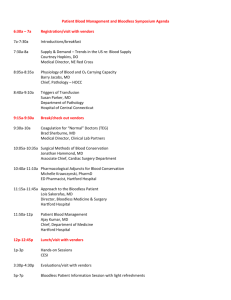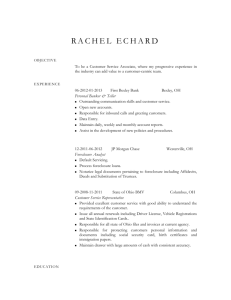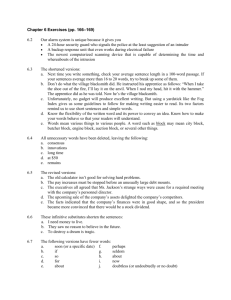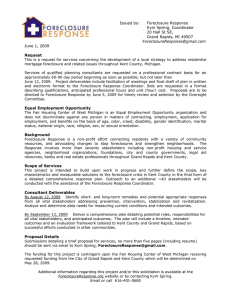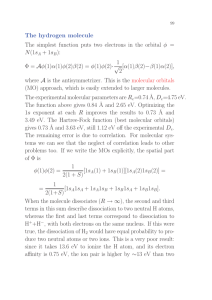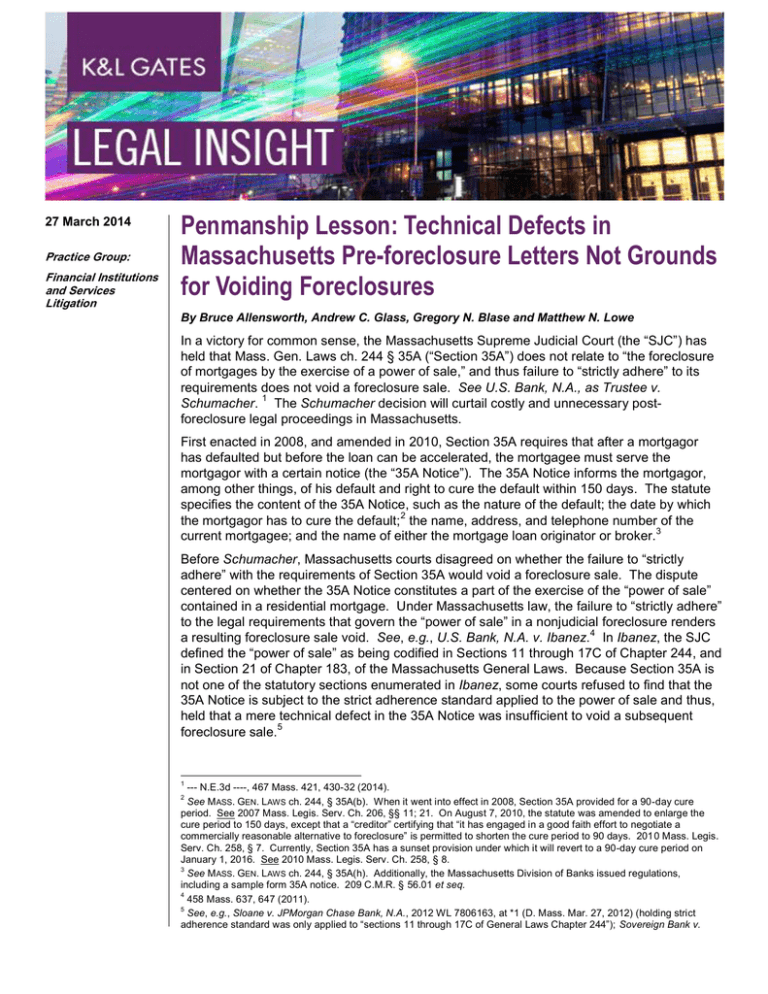
27 March 2014
Practice Group:
Financial Institutions
and Services
Litigation
Penmanship Lesson: Technical Defects in
Massachusetts Pre-foreclosure Letters Not Grounds
for Voiding Foreclosures
By Bruce Allensworth, Andrew C. Glass, Gregory N. Blase and Matthew N. Lowe
In a victory for common sense, the Massachusetts Supreme Judicial Court (the “SJC”) has
held that Mass. Gen. Laws ch. 244 § 35A (“Section 35A”) does not relate to “the foreclosure
of mortgages by the exercise of a power of sale,” and thus failure to “strictly adhere” to its
requirements does not void a foreclosure sale. See U.S. Bank, N.A., as Trustee v.
Schumacher. 1 The Schumacher decision will curtail costly and unnecessary postforeclosure legal proceedings in Massachusetts.
First enacted in 2008, and amended in 2010, Section 35A requires that after a mortgagor
has defaulted but before the loan can be accelerated, the mortgagee must serve the
mortgagor with a certain notice (the “35A Notice”). The 35A Notice informs the mortgagor,
among other things, of his default and right to cure the default within 150 days. The statute
specifies the content of the 35A Notice, such as the nature of the default; the date by which
the mortgagor has to cure the default;2 the name, address, and telephone number of the
current mortgagee; and the name of either the mortgage loan originator or broker.3
Before Schumacher, Massachusetts courts disagreed on whether the failure to “strictly
adhere” with the requirements of Section 35A would void a foreclosure sale. The dispute
centered on whether the 35A Notice constitutes a part of the exercise of the “power of sale”
contained in a residential mortgage. Under Massachusetts law, the failure to “strictly adhere”
to the legal requirements that govern the “power of sale” in a nonjudicial foreclosure renders
a resulting foreclosure sale void. See, e.g., U.S. Bank, N.A. v. Ibanez.4 In Ibanez, the SJC
defined the “power of sale” as being codified in Sections 11 through 17C of Chapter 244, and
in Section 21 of Chapter 183, of the Massachusetts General Laws. Because Section 35A is
not one of the statutory sections enumerated in Ibanez, some courts refused to find that the
35A Notice is subject to the strict adherence standard applied to the power of sale and thus,
held that a mere technical defect in the 35A Notice was insufficient to void a subsequent
foreclosure sale.5
1
--- N.E.3d ----, 467 Mass. 421, 430-32 (2014).
See MASS. GEN. LAWS ch. 244, § 35A(b). When it went into effect in 2008, Section 35A provided for a 90-day cure
period. See 2007 Mass. Legis. Serv. Ch. 206, §§ 11; 21. On August 7, 2010, the statute was amended to enlarge the
cure period to 150 days, except that a “creditor” certifying that “it has engaged in a good faith effort to negotiate a
commercially reasonable alternative to foreclosure” is permitted to shorten the cure period to 90 days. 2010 Mass. Legis.
Serv. Ch. 258, § 7. Currently, Section 35A has a sunset provision under which it will revert to a 90-day cure period on
January 1, 2016. See 2010 Mass. Legis. Serv. Ch. 258, § 8.
3
See MASS. GEN. LAWS ch. 244, § 35A(h). Additionally, the Massachusetts Division of Banks issued regulations,
including a sample form 35A notice. 209 C.M.R. § 56.01 et seq.
4
458 Mass. 637, 647 (2011).
5
See, e.g., Sloane v. JPMorgan Chase Bank, N.A., 2012 WL 7806163, at *1 (D. Mass. Mar. 27, 2012) (holding strict
adherence standard was only applied to “sections 11 through 17C of General Laws Chapter 244”); Sovereign Bank v.
2
Penmanship Lesson: Technical Defects in Massachusetts Pre-foreclosure
Letters Not Grounds for Voiding Foreclosures
Yet, in the past several years, former mortgagors facing post-foreclosure eviction sought to
void foreclosure sales, and thus avoid eviction, based on purely technical defects with a 35A
Notice. Like the mortgagor in Schumacher, many argued that the alleged failure to list the
current mortgagee or the alleged failure to list either the mortgage originator or mortgage
broker on the 35A Notice was sufficient to void a foreclosure sale. Several decisions of the
Massachusetts Housing Court, often with little or no analysis, had adopted this position.6
The SJC’s ruling in Schumacher abrogates those decisions.
In Schumacher, the mortgagor had been foreclosed upon and the foreclosing entity had
brought a post-foreclosure summary process action to evict him.7 In defense, the mortgagor
asserted that the foreclosure sale was void because of alleged, technical defects in the 35A
Notice that was sent prior to the loan’s acceleration, namely (1) in the field for mortgage
originator, the 35A Notice stated “N/A,” and (2) the 35A Notice listed the securitization trust
as the current mortgagee, even though a public assignment of the mortgage had not yet
been recorded.8 Thus, he argued, the foreclosing entity lacked standing to evict him
because it purportedly did not hold valid title to the property in light of the alleged defects in
the 35A Notice. Notwithstanding Schumacher’s identification of the alleged defects, the
Housing Court found that “no credible defenses were presented” by the mortgagor, and
entered summary judgment against him.9
On appeal, the SJC affirmed the Housing Court’s ruling and held that Section 35A is merely
a “pre-foreclosure undertaking” and not “one of the statute[s] ‘relating to the foreclosure of
mortgages by the exercise of a power of sale.’”10 The SJC reasoned that foreclosure is
correctly understood to be the “termination of all rights of the mortgagor … in the property
covered by the mortgage.”11 Section 35A, however, “is not the first step in terminating the
mortgagor’s right” because it expressly prohibits the acceleration of the debt during the cure
period, which “is a clear indication that foreclosure proceedings do not commence with the
issuance of the written [35A] notice.”12 Thus, Section 35A is not part of the “power of sale,”
and the failure to “strictly adhere” to the requirements of Section 35A is not grounds on which
to void a subsequent foreclosure sale.13
Sturgis, 863 F.Supp.2d 75, 102-03 (D. Mass. 2012); Fed. Home Loan Mortg. Ass’n v. Eccles, S.E. Hous. Ct., No. 11-SP4845, at 4 (Feb. 28, 2013); Aurora Loan Services, LLC v. Murphy, S.E. Hous. Ct., No. 12-SP-00521, at 3 (July 31, 2012).
6
See, e.g. Fed. Home Loan Mortg. Corp v. O’Connor, Worcester Hous. Ct., No. 12-SP-3164 (Feb. 20, 2013); Fed. Home
Loan Mortg. Corp. v. Sensini, N.E. Hous. Ct., No. 12-SP-0871, at 1 (Dec. 31, 2012) (failure to identify mortgage loan
broker or originator in 35A Notice rendered foreclosure invalid); Deutsche Bank v. Gomez, N.E. Hous. Ct., No. 12-SP3619, at 2 (March 13, 2013); Fed. Nat’l Mortg. Ass’n v. Drillis, N.E. Hous. Ct., No. 11-SP-3640, at 2 (Mar. 21, 2013)
(mortgagor argued foreclosure was void because 35A Notice failed to list mortgage originator or mortgage broker); Fed.
Home Loan Mortg. Corp. v. McIntosh, N.E. Hous. Ct., No. 11-SP-4387 (Feb. 21, 2013) (granting summary judgment
against foreclosing entity where the 35A Notice listed a mortgagee that was not the mortgagee of record until a later
assignment was recorded); Fed. Home Loan Mortg. Corp. v. Bisnath, N.E. Hous. Ct., No. 11-SP-4131 (Dec. 17, 2012);
see also Shin v. Consumer Solutions 3, LLC, 2013 WL 3778151, at *2 (Mass. Sup. Ct. July 8, 2013); Bravo-Buenrostro v.
Onewest Bank, FSB, 2011 WL 10818677, at *6 (Mass. Sup. Ct. May 31, 2011) (mortgagor argued foreclosure was void
because 35A Notice listed someone other than the current mortgagee of record).
7
Schumacher, 467 Mass. at 424-25.
8
Id. at 426, 427.
9
Id. at 427.
10
Id. at 431 (quoting M ASS. GEN. LAWS ch. 183 § 21).
11
Id. at 430 (quoting Levin v. Century Indem. Co., 279 Mass. 256, 259 (1932)).
12
Id. at 430-31.
13
Id. at 431.
2
Penmanship Lesson: Technical Defects in Massachusetts Pre-foreclosure
Letters Not Grounds for Voiding Foreclosures
In his concurrence, Justice Gants spoke about the “practical consequence” of the decision.
Justice Gants agreed that because Section 35A is not part of the power of sale, it is not
subject to the strict adherence standard. A technical violation of Section 35A, therefore, will
not void a foreclosure unless the violation is “so fundamentally unfair that [the mortgagor] is
entitled to affirmative equitable relief, specifically the setting aside of the foreclosure sale.” 14
The effect of the Schumacher decision is likely to be significant in Massachusetts—
especially in the context of post-foreclosure summary process actions against former
mortgagors. Under Schumacher, mortgagees will be able to argue that mortgagors cannot
raise technical defects in the 35A Notice as grounds to contest foreclosure or block eviction
where the foreclosure complied with the statutory requirements for exercising a power of
sale. The Schumacher decision, moreover, does not frustrate the legislative intent
underlying the 150-day cure period prescribed by Section 35A, which is “to give a mortgagor
a fair opportunity to cure a default before the debt is accelerated and before the foreclosure
process is commenced.”15
For additional information regarding the types of class actions defended by K&L Gates LLP
and the K&L Gates LLP lawyers who concentrate in class action defense and consumer
financial services litigation, please visit our practice group websites at
http://www.klgates.com/class-action-litigation-defense-practices/ and
http://www.klgates.com/financial-services-litigation-practices/.
Authors:
Bruce Allensworth
bruce.allensworth@klgates.com
+1.617.261.3119
Andrew Glass
andrew.glass@klgates.com
+1.617.261.3107
Greg Blase
greg.blase@klgates.com
+1.617.951.9059
Matthew Lowe
matthew.lowe@klgates.com
+1.617.951.9183
Anchorage Austin Beijing Berlin Boston Brisbane Brussels Charleston Charlotte Chicago Dallas Doha Dubai Fort Worth Frankfurt
Harrisburg Hong Kong Houston London Los Angeles Melbourne Miami Milan Moscow Newark New York Orange County Palo Alto Paris
Perth Pittsburgh Portland Raleigh Research Triangle Park San Diego San Francisco São Paulo Seattle Seoul Shanghai Singapore Spokane
Sydney Taipei Tokyo Warsaw Washington, D.C. Wilmington
14
15
Id. at 431-32.
Id. at 431 (emphasis added).
3
Penmanship Lesson: Technical Defects in Massachusetts Pre-foreclosure
Letters Not Grounds for Voiding Foreclosures
K&L Gates practices out of 48 fully integrated offices located in the United States, Asia, Australia, Europe, the Middle East and South
America and represents leading global corporations, growth and middle-market companies, capital markets participants and
entrepreneurs in every major industry group as well as public sector entities, educational institutions, philanthropic organizations and
individuals. For more information about K&L Gates or its locations, practices and registrations, visit www.klgates.com.
This publication is for informational purposes and does not contain or convey legal advice. The information herein should not be used or relied upon in
regard to any particular facts or circumstances without first consulting a lawyer.
©2013 K&L Gates LLP. All Rights Reserved.
4


